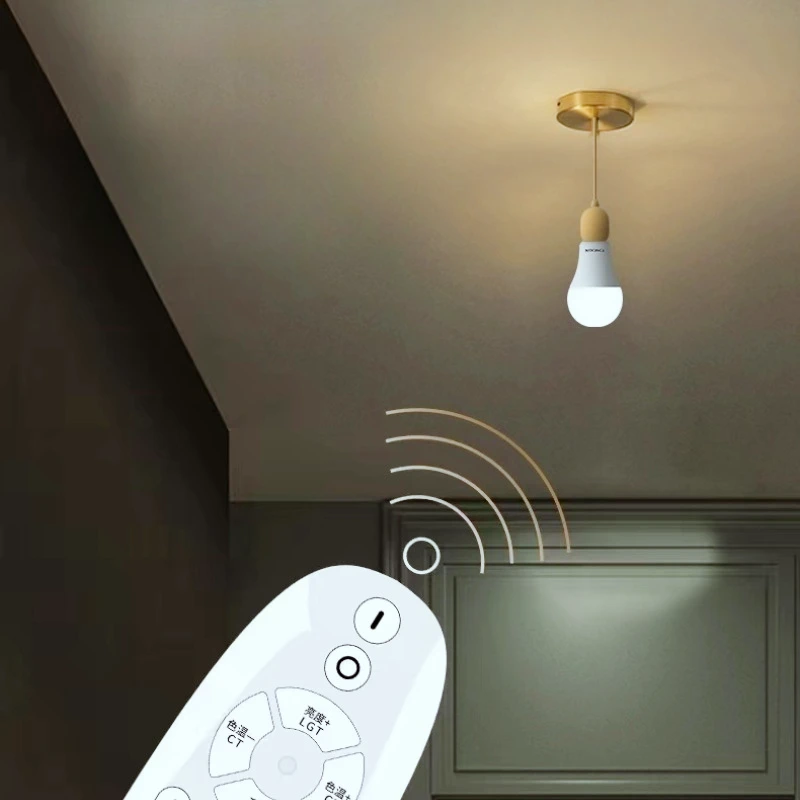Are LED Light Bulbs Dimmable
May 07, 2025
Are LED Light Bulbs Dimmable?
In today’s world, where comfort, energy efficiency, and environmental sustainability are a priority, LED light bulbs have become the mainstream lighting solution because of their high efficiency and long lifespan. Many individuals may confuse: Are LED light bulbs dimmable? The response is affirmative; however, it is important to note that not all LED bulbs are compatible with dimming features. We’ll explore everything you need to know about dimmable LED bulbs in this blog, helping you find the best lighting solution for your home.
1. What Are LED Bulbs?
LED bulbs, or light-emitting diode bulbs, are a type of lighting product that uses LEDs as the light source. Compared to traditional incandescent and CFL bulbs, LED bulbs offer significant advantages, including low energy consumption, long lifespan, and environmental friendliness.
Low Energy Consumption: LED bulbs consume only 1/10th of the energy of incandescent bulbs for the same brightness.
Long Lifespan: LED bulbs typically last between 20,000 to 50,000 hours, far exceeding the 1,000-hour lifespan of incandescent bulbs.
Environmentally Friendly: LEDs contain no mercury, reducing environmental pollution.
However, while LED bulbs are incredibly versatile, their dimming capability requires specific design and compatibility.
2. Types of LED Bulbs
There are various types of LED bulbs on the market, which can be classified by their functionality:
| Type | Features | Best For |
| Non-Dimmable LED | Fixed brightness, cannot be adjusted, relatively inexpensive | General home, office, and corridor lighting |
| Dimmable LED | Adjustable brightness, requires a compatible dimmer switch, slightly more expensive | Living room, bedroom, and dining room lighting |
| Smart Dimmable LED | App or voice-controlled (e.g., Wi-Fi, Zigbee), adjustable color temperature and brightness, higher cost | Living room, bedroom, and dining room lighting |
3. What Is a Dimmable LED Bulb?
A dimmable LED bulb is, as the name suggests, an LED bulb that allows you to adjust its brightness. It achieves a continuous dimming range from 10% to 100% by modifying the input current or voltage. This feature creates a softer light, perfect for different lighting needs in various settings.
Key Features of Dimmable LED Bulbs:
Compatible with Dimmers: Requires a dimmer switch using technologies like TRIAC, MOSFET, or smart dimming switches.
Flicker-Free: High-quality dimmable LEDs use constant current drivers to avoid flickering, which can strain the eyes.
Smooth Dimming: Supports linear dimming, ensuring smooth transitions in brightness.

4. How Do LED Bulbs Achieve Dimming?
LED dimming relies on different technologies:
(1) Leading-Edge Dimming (TRIAC)
Principle: Uses a silicon-controlled rectifier (SCR) to cut the AC waveform, adjusting the voltage to control brightness.
Pros: Cost-effective and compatible with traditional dimmer switches.
Cons: May cause flickering or buzzing at lower brightness levels.
(2) Trailing-Edge Dimming (MOSFET)
Principle: Uses a transistor to control the current, allowing for smoother dimming.
Pros: Flicker-free, supports dimming to lower brightness levels.
Cons: Higher cost, requires a specialized dimmer.
(3) Smart Dimming (PWM/DALI)
Principle: Uses pulse-width modulation (PWM) or digital control signals (DALI) to adjust brightness.
Pros: Precise control, you can remotely control the LED bulb via smart systems.
Cons: Requires smart systems, high cost.

5. Best Applications for Dimmable LED Bulbs
Dimmable LED bulbs are not suitable for all spaces, but they excel in the following environments:
| Scene | Why It Works | Dimming Recommendation |
|---|---|---|
| Living Room | Adjustable light for watching movies, hosting guests, or reading | Set to 30%-80% brightness with warm light |
| Bedroom | Dimming the lights before sleep or reducing glare for late-night use | Adjust brightness to 10%-50% for a soft glow |
| Dining Room | Warm light for meals, higher brightness for everyday tasks | Adjust color temperature between 2700K and 3000K |
| Study Room | Bright lighting for reading, lower brightness for relaxation | Use 4000K natural light, with adjustable brightness |
| Hotel/Cafe | Flexible lighting to enhance the customer experience | Smart dimming with a remote control |
6. Pros and Cons of Dimmable LED Bulbs
Advantages
1. Energy Efficient and Eco-Friendly
Dimming an LED bulb reduces its brightness and power consumption, which not only cuts electricity bills but also extends the lifespan of the bulb. It’s a smart way to go green without compromising on comfort.
2. Customizable Lighting for Any Occasion
Whether you're reading, relaxing, hosting a dinner, or winding down at night, dimmable LED bulbs allow you to set the perfect mood with adjustable brightness.
3. Gentle on the Eyes
Harsh lighting can strain your eyes. Dimmable bulbs help you avoid this by providing softer illumination during nighttime or in low-light settings.
4. Smart Home Compatibility
Many dimmable LEDs now support smart controls via apps, voice assistants like Alexa, Google Assistant, or platforms like Apple HomeKit—making them a key player in any smart lighting setup.
Disadvantages
1. Higher Upfront Cost
Compared to standard LED bulbs, dimmable versions tend to be more expensive due to the added components required for dimming functionality.
2. Compatibility Issues
Not all dimmers work with all LED bulbs. Some require specific types (like TRIAC dimmers) for optimal performance. Using the wrong dimmer may cause flickering or prevent dimming entirely.
3. Low Brightness Limitations
Some dimmable LEDs may not dim down. At low brightness, you might notice residual glow or flickering.
7. Do Dimmable LED Bulbs Require Maintenance?
Dimmable LED bulbs are generally low-maintenance, but a few practices can help maximize their performance and longevity:
1. Dust Occasionally
Dust buildup can trap heat and affect performance. Wipe the bulb surface with a dry cloth every few months.
2. Check Dimmer Compatibility
If your bulb flickers or dims inconsistently, the issue may lie with the dimmer switch. Make sure your dimmer is LED-compatible.
3. Avoid Frequent Switching
Rapidly turning the lights on/off or changing brightness frequently can put stress on the driver circuitry. Smooth, gradual adjustments are better.
4. Ensure Proper Ventilation
The working temperature of the LED bulb is between -20 and -45 degrees Celsius. If it is used in extreme temperatures, it should not be operated for extended periods. Additionally, it is important to use fixtures that allow for heat dissipation to prevent premature wear or loss of brightness.
8. Frequently Asked Questions About Dimmable LED Bulbs
Q1: Are all LED light bulbs dimmable?
No. Only those clearly labeled as “Dimmable” are designed to work with dimming functions. Please always check the packaging or product specs before buying.
Q2: Can I use a dimmable LED bulb with a regular dimmer switch?
Not always. Many older or traditional dimmers (like TRIAC-based models) aren’t optimized for low-wattage LEDs. To avoid issues, use a dimmer specifically designed for LED lighting.
Q3: What should I do if my dimmable LED bulb flickers or buzzes?
This usually points to an incompatible dimmer or an insufficient electrical load. Try replacing the dimmer or adding a resistive load to stabilize performance.
Q4: Does dimming affect the lifespan of LED bulbs?
In general, dimming can extend the life of your bulb by reducing heat and power usage. However, using a poor-quality dimmer can cause unstable voltage, which may shorten the bulb’s lifespan.
Q5: What’s the difference between smart dimmable LEDs and standard dimmable bulbs?
Smart bulbs offer wireless control via apps or voice commands (like Philips Hue or Yeelight). Standard dimmable bulbs require a manual dimmer switch and lack connectivity features.
Q6: Can dimmable LED bulbs reach near-total darkness at their lowest setting?
Some high-end models can dim as low as 1% brightness, which is nearly off. However, most mainstream options will emit a faint glow even at their lowest settings.
Conclusion
Dimmable LED bulbs make lighting smarter and more customizable, but it’s essential to consider compatibility (whether your existing dimmer is supported) and quality (to avoid flickering that could harm your eyes). If you want lighting that adapts to your needs, try dimmable LED bulbs and enjoy more flexibility in your home!
We hope this article helps explain your questions about dimmable LED bulbs. If you have any further questions, please don't hesitate to reach out to us directly.
